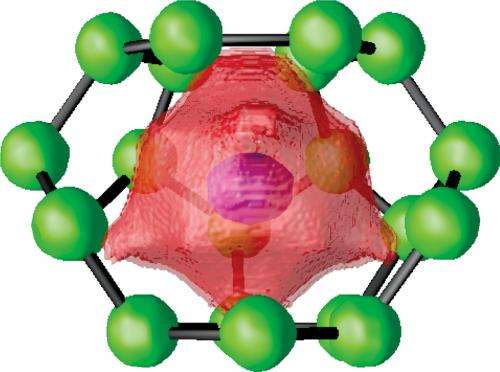More efficient energy use could result from a direct experimental observation of atomic behavior inside nanoscale cages

Thermoelectric generators can make better use of the excess heat generated by machines by converting temperature differences directly back into electricity. Now, Masaki Takata from the RIKEN SPring-8 Center, Harima, working in collaboration with colleagues at institutions across Japan, have shown how the thermoelectric properties of a class of materials known as clathrates are enhanced by their unusual atomic structure, thus demonstrating a potential route to more efficient energy usage.
Clathrates consist of a lattice-work of cages of 'host' atoms inside which loosely bound 'guest' atoms are trapped. Akin to a baby's rattle, the guest atoms are free to rattle around their confines. By using x-rays to visualize the electrostatic interactions between atoms, Takata and his colleagues' work provides a more complete understanding of how rattling influences the thermoelectric properties of clathrates. Their methodology enabled them to construct a quantitative relation between the degree of guest–atom motion and thermal conductivity, which will be useful for engineering future materials for thermoelectric applications.
When an ordinary solid material is heated, the thermal energy causes the atoms to vibrate. In response to this motion, neighboring atoms also start oscillating, thereby conducting heat through the medium. Scientists believe that the rattling in clathrates disrupts and scatters the flow of thermal energy. Consequently, the energy passes to neighboring atoms in a non-coherent way, thus inhibiting thermal conduction. Importantly, this inhibition occurs with little effect on the electrical conductivity of the material. "In thermoelectric generators, low thermal conductivity is preferable for keeping the temperature difference, whereas high electrical conductivity is essential for reducing loss of the generated electricity," explains Akihiko Fujiwara from the Japan Synchrotron Radiation Research Institute, a co-author of the paper.
Takata and his colleagues studied clathrates with polyhedron cages made of germanium and gallium, containing a guest atom of either barium or strontium. They fired beams of radiation at the samples and, from the way these beams were deflected, imaged the electrostatic potential in the cage, which clearly exhibited signs of the guest atom rattling. They observed that the clathrates with a larger electrostatic interaction area also displayed a commensurately reduced thermal conductivity, confirming that rattling is responsible for the improved thermoelectric properties.
"Next we hope to extend our method for visualizing such invisible interactions to other electronic functions, such as superconductivity and ferroelectricity, which will be useful for designing future novel materials," says Fujiwara.
More information: Fujiwara, A., Sugimoto, K., Shih, C.-H., Tanaka, H., Tang, J., Tanabe, Y., Xu, J., Heguri, S., Tanigaki, K. & Takata, M. Quantitative relation between structure and thermal conductivity in type-I clathrates X8Ga16Ge30 (X = Sr, Ba) based on electrostatic-potential analysis. Physical Review B 85, 144305 (2012). prb.aps.org/abstract/PRB/v85/i14/e144305
Journal information: Physical Review B
Provided by RIKEN


















